


An online soybean pest survey has been developed from a Pest Management Strategic Planning meeting held in August 2003. This is survey is intended for producers and others involved with soybean production in Kentucky, Tennessee, southern Illinois, and southern Indiana.
You can access this survey at: http://www.sripmc.org/KY/SoybeanPMSPSurvey/
The purpose of this survey is to demonstrate producer input on critical pest issues relative to soybean production in this region of the county. This information will be used by the United States Department of Agriculture (USDA) and the Environmental Protection Agency (EPA) in making decisions about pesticide registration issues and prioritization for the funding of extension and land-grant/government research projects.
This survey was developed through the Kentucky Pest Management Center (KPMC). The KPMC is a grant-funded program in the UK Entomology Department. We develop Crop Profiles and Pest Management Strategic Plan documents for commodities in Kentucky and the region. These documents were designed as a method for producers and those with first-hand or hands-on knowledge to provide input on what pest management tools are most critical for the production of Kentucky commodities. More information can be found at http://www.uky.edu/Agriculture/KPMC/KPMC.htm.
This is your chance to collectively provide "first-hand"
information to the USDA and EPA on current troublesome
pests and the potential impact of emerging pests. We
encourage those involved with soybean production in this
region (producers, industry, and extension) to take 10 to 20
minutes out of your day to provide your input on these critical
pest management issues.


 Corn planting is in full swing this week. Many growers
this year have decided to use seed treatments (Gaucho,
Prescribe, Cruiser, Poncho) to control soil insect pests. The
advantages and disadvantages of these treatments have
been discussed in previous newsletter articles. But one
word of caution for growers is to monitor these fields for
cutworms over the coming weeks. While these treatments
will help to reduce cutworm problems, none of these seed
treatments will completely prevent cutworm damage in all
situations. These fields still need to be scouted!
Corn planting is in full swing this week. Many growers
this year have decided to use seed treatments (Gaucho,
Prescribe, Cruiser, Poncho) to control soil insect pests. The
advantages and disadvantages of these treatments have
been discussed in previous newsletter articles. But one
word of caution for growers is to monitor these fields for
cutworms over the coming weeks. While these treatments
will help to reduce cutworm problems, none of these seed
treatments will completely prevent cutworm damage in all
situations. These fields still need to be scouted!
While planting corn with these seed treatments, growers may realize a savings in time not having to mix/apply soil insecticides during planting. Planters don't need to be calibrated. But additional care must be taken with these seed treatments not to leave exposed seed on the ground. Birds and other wildlife need to be protected from the treated seed.
For information about corn pests, visit
"Insect Management Recommendations".


 As our orchards begin to flower, pheromone traps for
codling moth and Oriental fruit moth need to be placed in
trees. With newer more selective growth regulators, timing
of insecticide sprays for codling and Oriental fruit moth is
much more important. Pheromone traps are used to
estimate when egg hatch will occur and correctly time
insecticide applications. Growers should use a minimum
of two traps per orchard for each type of insect to be
monitored with at least one trap per every ten acres of
trees.
As our orchards begin to flower, pheromone traps for
codling moth and Oriental fruit moth need to be placed in
trees. With newer more selective growth regulators, timing
of insecticide sprays for codling and Oriental fruit moth is
much more important. Pheromone traps are used to
estimate when egg hatch will occur and correctly time
insecticide applications. Growers should use a minimum
of two traps per orchard for each type of insect to be
monitored with at least one trap per every ten acres of
trees.
While many growers use Imidan and Guthion for codling moth control, Oriental fruit moth and codling moth have appeared to become more resistant to these sprays in some orchards. In these orchards, growers have switched to other types of insecticides. Guthion and Imidan have been applied at 250 degree days past biofix, just when egg hatch begins (See Entfact 203). While newer insecticides such as Confirm, Intrepid, Assail, Calypso, Esteem, and Spintor are used earlier, generally just after egg laying begins.
Traps should be hung in the southwestern quadrant of the
tree, five to six feet off the ground. Traps need to on a tree
that is representative of other trees in the orchard, so I
generally do not place them on outside rows.


Drs. Richard M. Riedel and Robert J. Precheur with the vegetable team at Ohio State University recently published an excellent article in their VegNet Vol. 11, No. 4. Ohio State University Extension Vegetable Crops concerning some significant changes in labeling of fungicides for commercial vegetables. Some of the items they covered developed too late to make our revisions to ID-36, "Vegetable Production Guide for Commercial Growers". Their comments are equally appropriate for commercial vegetable growers in Kentucky, so the article is reprinted below, in full, with their permission. The only item they mention which does not fully fit the Kentucky situation (but is still very appropriate for Kentucky) is that we have not used the FRAC Code (Fungicide Resistance Action Committee - fungicide classification) numbers in our recommendation, but have used the class or group names. The labels for these products usually have both.
"Vegetable growers will notice this season that fungicide labels and vegetable production recommendations will contain Frac Codes and Site of Action groups
Numbers and letters indicate those fungicide classes, which will lead to the development of resistant strains of fungi if used on a continuous basis. These fungicide classes should be alternated with another fungicide class during a spray program.
If field resistance is known to one member of the Group, it is most likely but not exclusively valid that cross resistance to other Group members will be present.
FRAC Code. Numbers and letters are used to distinguish the fungicide groups. The numbers were assigned primarily according to the time of product introduction to the market. The letters refer to P = host plant defense inducers, M = multi-site inhibitors, and U = recent molecules with unknown mode of action.
Some examples used to identify group names are: 1- benzimidazole; 2-dicarboximide; 3-triazole; 4- phenylamide; 7-carboximide; 9-pyridinamine; 11-QoI MET complex 3 inhibitor; 14-aromatic hydrocarbon;
Target Site of Action. If available the biochemical mode of action is given (e.g. Group 11). In many cases the precise target site is not known.
Fungicide Updates for 2004, Mode of action Sites Site of Action Group 11
Amistar 80G, new formulation of Azoxystrobin (Quadris); Syngenta
Tomatoes, pumpkins and a wide range of vegetables
including (bean beets carrots celery, cucurbits, eggplant,
leafy greens, onion, peas, pepper, potato and tomato.
Resistance management as with other strobilurons
Cabrio 20 EG (pyraclostrobin); BASF
Labeled for control of Late Blight, Early Blight, Septoria
Leaf Spot, PM and Anthracnose on tomato. Other
vegetables include: beets carrots, cucurbits, eggplant,
garlic, horseradish, leek, onion, pepper, radish and turnip.
Cabrio labeled for control of White Speck (Microdochium
Blight = Plectosporium Blight)
REI=12 hr; PHI=0 day
Resistance management required
Tanos 50DF (25% Famoxadone, 25% Cymoxanil); DuPont
Labeled on tomato for Late Blight, Early Blight, Septoria
Leaf Spot, Anthracnose; Suppresses Bacterial Spot &
Speck, Buckeye Rot
Anthracnose, Downy Mildew on Pumpkin
Other labeled vegetables include: cucurbits, pepper and
potato.
REI=12 hr, PHI=3 days/resistance management required
Do not use in U-Pick operations
Site of Action Group 7
Endura (Boscalid, a carboximide fungicide); BASF
Labeled for bean, carrot, eggplant, lettuce, onion, pepper,
and potato. Labeled on tomato for Early Blight, Septoria
Leaf Spot, White Mold (Timber Rot), Botrytis, Powdery
Mildew
Nothing on Pumpkin yet
REI=12 hr, PHI=0 days
Resistance Management required
Site of Action Group 7+11
Pristine (Cabrio + Endura); BASF
Labeled for dry bulb, cucurbits and root vegetables
NOT labeled for tomatoes.
REI=12 hr, PHI =0-30 days (check crop label)"

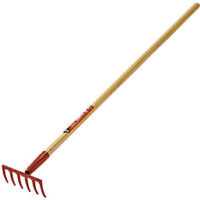
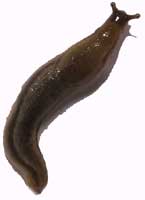 Slugs are almost universal pests in vegetable gardens,
shade gardens, and shaded landscape areas. Their soft,
unsegmented bodies, exude a slimy, mucous-like
substance that leaves characteristic shiny trails as they
move from hiding to feeding spots. Once on a plant, slugs
use their rasping mouthparts to scrape away at the leaf
tissue. Immature slugs tend to feed on surface tissue while
larger individuals eat rounded holes completely through
the leaf. Slugs usually feed at night and hide in moist, dark
areas during the day. They may eat several times their
own body weight each night so serious damage can occur
in a very short time. Disappearance of seedlings or newly
set transplants is often blamed on cutworms but slime
trails are a key clue in incriminating slugs.
Slugs are almost universal pests in vegetable gardens,
shade gardens, and shaded landscape areas. Their soft,
unsegmented bodies, exude a slimy, mucous-like
substance that leaves characteristic shiny trails as they
move from hiding to feeding spots. Once on a plant, slugs
use their rasping mouthparts to scrape away at the leaf
tissue. Immature slugs tend to feed on surface tissue while
larger individuals eat rounded holes completely through
the leaf. Slugs usually feed at night and hide in moist, dark
areas during the day. They may eat several times their
own body weight each night so serious damage can occur
in a very short time. Disappearance of seedlings or newly
set transplants is often blamed on cutworms but slime
trails are a key clue in incriminating slugs.
Slugs prefer temperatures in the low 60's but can lay eggs and develop normally down to about 40 F. They can survive slight freezing but tend to hide in cracks and crevices when cold weather threatens them. Usually, warm temperatures are the concern. Slugs try to avoid temperatures above 70. Rising temperatures spur them to crawl down to their hiding places to rest and absorb water through their skin. As temperatures start to fall, slugs actively begin foraging, again. Slugs are so sensitive to temperature that they can detect changes as gradual as 2 F per hour!
Slugs are very sensitive to air currents. Gentle breezes cause them to turn toward the source and extend their antennae. As the breeze becomes stronger, they turn away from the source, evidently to escape dehydration. Improved ventilation of a trouble spot may make it drafty and force slugs to move. Good sanitation, including removal of extraneous vegetation, excess mulch, or other materials that might offer food or shelter, will aid in the overall control program.
Slug baits containing metaldehyde or iron phosphate may be used for control. Best results are usually obtained if the baits are applied in the afternoon watering is delayed until the next day. Slugs feed intermittently so several applications of bait may be needed for control. Baits may attract slugs from up to 3 feet away.
Beer-baited traps will lure in many slugs but is it important to check and empty the traps regularly. Pieces of wood, cardboard, or other objects can be placed on the ground in infested areas to provide hiding sites for foraging slugs. Regular visits to the slug accumulators will allow you to collect and discard the resting slugs.
Barriers can provide some relief if the slugs are moving in from outside the area that is being protected. Wood ash or fine lime can be used but both lose their effectiveness when wet and too much wood ash is not good for the soil. Slugs do not like to cross copper. A copper barrier tape (about 1" wide) can be used along borders or around the legs of greenhouse tables to deter slugs. There are wider copper barriers that can be set in the soil as fences but the expense makes this most suitable for small areas.
(Adapted in part from Florida Cooperative Extension Service
information) Also see Entfact-407, Slugs.

 Springtails are tiny wingless insects that can flip into the
air, giving them the appearance of tiny fleas. They would
go completely unnoticed except that hundreds of them can
accumulate on surfaces like a small, dusty gray carpet that
moves.
Springtails are tiny wingless insects that can flip into the
air, giving them the appearance of tiny fleas. They would
go completely unnoticed except that hundreds of them can
accumulate on surfaces like a small, dusty gray carpet that
moves.
Most springtails live in rich soil or leaf litter, under bark or decaying wood, or associated with fungi. Many are scavengers, feeding on decaying plants, fungi, molds, or algae. Springtails become abundant among wet leaves, soil, and plant material along a house foundations or sidewalks where they can be a temporary annoyance. They also can occur around floor drains, in damp basements, and crawl spaces. Masses of these insects can be swept up and discarded.
Most common springtails do not survive in dry conditions. Any steps to improve ventilation and promote drying are the best long term solutions. Removal of accumulations of wet leaves or other organic matter will eliminate breeding sites. Aerosol household insecticides can be used to treat infestations but will provide only temporary relief if the favorable conditions are not corrected.
Midges and gnats are common names for a large number of small, non-biting flies. Many species look like mosquitoes and may form annoying swarms or clouds in the air but they do not bite. The immature stages develop in water in pools, containers, ponds, clogged rain gutters, or in some cases, wet soil or seepage areas. Most feed on living or decaying plant matter and are an important part of aquatic food chains. Many species can survive in very stagnant or polluted water.
There are no good alternatives for control of the adults.
They usually do not feed and die in a few days. If
necessary, resting accumulations can be treated with an
aerosol spray containing pyrethrins. These are impractical
for treating anything other than small areas. These
products only kill insects that are directly hit by spray
particles; there is no lasting or residual effect.

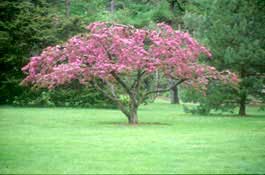
Last week, a proposed Kentucky quarantine against nursery stock from California due to the threat of spread of Sudden Oak Death (SOD) disease was described in this newsletter. On March 26, 2004, the quarantine, issued by the Kentucky Office of State Entomologist, officially went into effect. This quarantine prohibits shipment and sale of plants, unprocessed wood such as firewood and lumber, wreaths, garlands, and greenery from the state of California.
A memo announcing the quarantine was sent to Kentucky
nurseries and dealers by Joe Collins, Nursery Inspector on
April 2, 2004. In the memo, the quarantine is justified
based on insufficient knowledge of the true host range of
the SOD pathogen and on the fact that Kentucky's
hardwood forests contain many susceptible hosts. The
plant host list continues to grow and currently includes 59
hosts. The quarantine is intended to protect Kentucky's
nursery and forest industries. For details of the
quarantine, see the web site:
http://www.uky.edu/Agriculture/NurseryInspection and click
under "hot topics."

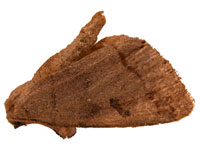 Specimens of the common oak moth were collected in
Breckinridge county late last week. They were relatively
common in a wooded area that was heavily attacked by
this insect last year. The common oak moth has been active
for the past 2 to 3 years over a wide range of the eastern
and central part of the state, especially attacking white oak.
Specimens of the common oak moth were collected in
Breckinridge county late last week. They were relatively
common in a wooded area that was heavily attacked by
this insect last year. The common oak moth has been active
for the past 2 to 3 years over a wide range of the eastern
and central part of the state, especially attacking white oak.
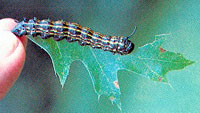 There is one generation each year with the caterpillars
feeding during May and June. The larvae are brown with
tan to black blotches on the sides. The back is checkered
with diamond-shaped markings and slanted lines. The
larvae move like inch-worms and will be about 1-1/4
inches long when full-grown.
There is one generation each year with the caterpillars
feeding during May and June. The larvae are brown with
tan to black blotches on the sides. The back is checkered
with diamond-shaped markings and slanted lines. The
larvae move like inch-worms and will be about 1-1/4
inches long when full-grown.


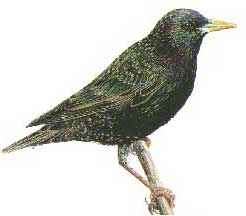 Despite their beneficial role in nature, birds can become
pests when they nest or roost around structures. In the
coming weeks, clients will experience various problems
stemming from birds on their premises.
Despite their beneficial role in nature, birds can become
pests when they nest or roost around structures. In the
coming weeks, clients will experience various problems
stemming from birds on their premises.
Significance as Pests - Pigeons, starlings and sparrows cause millions of dollars in damage by defacing buildings, sidewalks and cars with their droppings. Gutters, down spouts and air vents may become obstructed by nesting materials, and the feathers, filth, and carcasses can lead to secondary problems by attracting carpet beetles, flies and other scavenger insects. Birds nesting around buildings may pose a health hazard to people and farm animals. Mites, lice and bedbugs can invade living areas and bite humans after the nestlings leave or a bird dies. Birds can also transmit salmonellosis (food poisoning), or histoplasmosis and cryptococcosis systemic fungal infections acquired by inhaling airborne spores, which grow in bird droppings.
Bird mites- These bloodsucking ectoparasites normally live on the birds or in their nests, but will sometimes disperse into buildings when birds die or abandon the nest. People become aware of the problem when they are attacked by mites searching for an alternate food source. The bites cause itching and irritation, but do not result in disease. Bird mites are tiny but can be seen with the naked eye. They are about the size of the period at the end of this sentence, and appear as slow-moving specs as they crawl about on walls and other surfaces.
Bird mites can survive several days without a host. Unless corrective measures are taken, the occupants will probably continue to be bitten. The first step in controlling bird mites is to remove the birds and their nests. Nests typically will be found in attics, around eaves, window ledges, and rafters, or in gutters or chimneys. Wear gloves when handling dead birds, and a respirator when removing nesting materials to avoid inhaling fungal spores and other potential disease-producing organisms associated with the droppings.
After nests are removed, the nest location and adjacent areas should be sprayed with an insecticide such as those labeled for flea control. Pyrethrin and carbaryl are examples of effective active ingredients. A vacuum cleaner or cloth moistened with alcohol or dilute ammonia solution can be used to eliminate mites crawling on walls, floors and other indoor surfaces. Laundering (hot or warm cycle) will kill any mites crawling on clothing or bedding.
Bird Management - The most effective way to avoid problems with pest birds around buildings is to deny them nesting and roosting sites. The best time to do this is before nests are well established. Vents and other small openings should be sealed with 1/4-inch hardware cloth or similar exclusion materials. Attic vents may need to be screened or netted on the exterior to prevent sparrows from nesting between the louvers. Nesting or roosting on ledges, eaves, window sills and other surfaces can be deterred by installing tightly strung, parallel strands of wire just above the surface of the ledge. Roosting can also be discouraged by changing the angle of the ledge to 45 degrees or more with sheet metal or wood boards. "Porcupine" wires, coils, repellent gels, or netting are effective provided they are correctly installed. Homeowners can purchase bird exclusion materials at hardware or farm supply stores, or may want to call a professional pest control firm.
Before installation, remove nests and droppings to avoid potential problems with scavenger insects and disease pathogens. Gloves and a respirator equipped with a HEPA (high efficiency particulate air) filter should be worn to avoid inhaling fungal and bacterial spores (a dust mask alone is insufficient). Lightly moistening droppings and nesting materials with water before removal reduces the tendency for dust and spores to become airborne.
Fake owls, rubber snakes, brightly colored balloons, etc. are sold as deterrents to nesting. These devices usually fail because birds soon become acclimated to their presence and ignore them. If these devices are tried, reposition them periodically or vary the pattern. Repeated disruption of nest-building activities, such as with loud sounds or the spray from a water hose, can be effective but require persistence. Such efforts should ideally begin before the birds have formed a strong attachment to the site. If frightening efforts are to be successful, they must continue for several days and may need to be repeated if the birds decide to rebuild. Toxic baits or shooting of birds should be avoided and in many areas is illegal. Large or complicated bird jobs usually require the expertise of a professional pest control or nuisance wildlife firm.
Finally, any leftover bird seed from winter feeding should
be stored in tight-fitting containers. Unsealed bags of seed
left in the garage or basement are prime targets for meal
moths, mice and other pests.


Special Local Need (SLN) registrations are unique in that they are implemented by individual states. The part of the Federal Insecticide, Fungicide, and Rodenticide Act (FIFRA) that describes this authority is Section 24 ( c ); consequently these registrations are often referred to as 24( c) registrations. Although there are instances of 24 ( c ) registered uses approved independently in several states, the label is still regarded as a state label and is regulated as such.
The Division of Environmental Services Pesticide Regulation is a part of the Kentucky Department of Agriculture that regulates pesticides and has the responsibility and authority for approving or denying 24( c ) registrations. Once a 24 ( c ) registration has been approved by the Division, it is reviewed by the Federal EPA, which has the general oversight of 24 ( c ) registrations.
Based on the current policy of the Division of Environmental Services Pesticide Regulation, 24(c) registrations expire on December 31 of the third year from which they are approved. For example, if a registration is approved on June 21, 2004, it will expire December 31, 2006. SLN registrations are eligible for renewal if reviewed and approved according to the state's guidelines.
Listed below are 24(c) registrations approved specifically for Kentucky.
Acrobat MZ
Registrant: BASF
Registered use: For controlling metalaxyl/mefanoxam-
resistant blue mold in field-grown tobacco.
SLN registration no.: KY-030006
Expiration date: 12/31/2005
Compound DRC 1339 Concentrate
Registrant: US Department of Agriculture Animal, Plant
Health Inspection Service
Registered use: For bird control in feedlots
SLN registration no.: KY-020003
Expiration date: 12/31/2004
Compound DRC 1339 Concentrate
Registrant: US Department of Agriculture Animal, Plant
Health Inspection Service
Registered use: For bird control in staging areas
SLN registration no.: KY-020002
Expiration date: 12/31/2004
Dithane DF Rainshield
Registrant: Dow AgroSciences
Registration use: For control of blue mold, anthracnose, &
damping-off in seedling & field grown tobacco.
Registration no.: KY-020001
Expiration date.: 12/31/04
Dual Magnum
Registrant: Syngenta
For weed control in transplanted bell peppers.
Registration no.: KY-030004
Expiration date: 12/31/2005
Note: End users are required to sign wavier of liability and
indemnification form via Kentucky Vegetable Growers
Association (KVGA)
Dual Magnum
Registrant: Syngenta
Registered use: For weed control in transplanted cabbage.
Registration no.: KY-030003
Expiration date: 12/31/2005
Note: End users are required to sign wavier of liability and
indemnification form via Kentucky Vegetable Growers
Association (KVGA)
Gramoxone Max
Registrant: Syngenta
For burndown control of weeds & cover crops in no-till
tobacco
Registration no.: KY-020004
Expiration date: 12/31/04
Poast Herbicide
Registrants: BASF and Micro Flo
Registered use: For postemergence grass control in
tobacco
Registration no.: KY-030005 for BASF and KY-030007 for
Micro Flo
Expiration date: 12/31/2005
Strongarm
Registrant: Dow AgroSciences
Registered use: For broadleaf weed control in cottonwood
planting.
Registration no.: KY-040001
Expiration date: 12/31/06
Tracer
Registrant: Dow AgroSciences
For control of tobacco budworm and tobacco hornworm in
field grown tobacco.
Registration no.: KY-030001
Expiration date: 12/31/2005


Recent samples in the Diagnostic Lab have included
several greenhouse samples: cold injury symptoms on
tobacco; growth regulator injury on tomato; black root rot
on geranium; and nitrogen deficiency on petunia. We also
diagnosed wheat spindle streak mosaic virus on wheat;
several cases of black root rot on holly, and winter injury
on boxwood, euonymus and privet.


UKREC-Princeton, KY, March 26 - April 2, 2004| True armyworm
| 16
| Black cutworm
| 0
| | |
For information on trap counts in southern Illinois visit the Hines Report at - http://www.ipm.uiuc.edu/pubs/hines_report/index.html. The Hines Report is posted weekly by Ron Hines, Senior Research Specialist, at the University of Illinois Dixon Springs Agricultural Center.
NOTE: Trade names are used to simplify the information presented in this newsletter. No endorsement by the Cooperative Extension Service is intended, nor is criticism implied of similar products that are not named.
Lee Townsend
Extension Entomologist